sensor SUZUKI SWIFT 2000 1.G RG413 Service Owners Manual
[x] Cancel search | Manufacturer: SUZUKI, Model Year: 2000, Model line: SWIFT, Model: SUZUKI SWIFT 2000 1.GPages: 698, PDF Size: 16.01 MB
Page 425 of 698
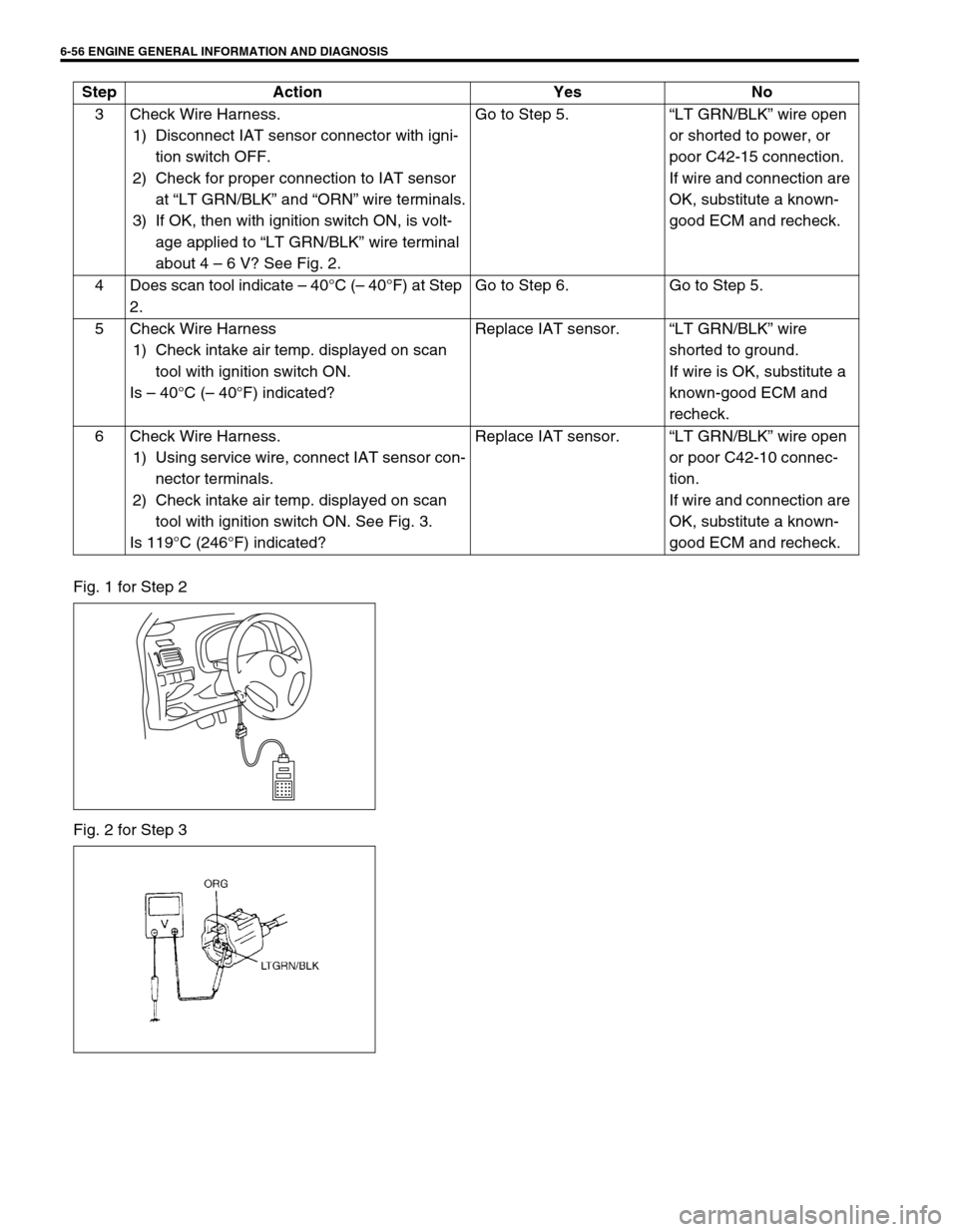
6-56 ENGINE GENERAL INFORMATION AND DIAGNOSIS
Fig. 1 for Step 2
Fig. 2 for Step 33 Check Wire Harness.
1) Disconnect IAT sensor connector with igni-
tion switch OFF.
2) Check for proper connection to IAT sensor
at “LT GRN/BLK” and “ORN” wire terminals.
3) If OK, then with ignition switch ON, is volt-
age applied to “LT GRN/BLK” wire terminal
about 4 – 6 V? See Fig. 2.Go to Step 5.“LT GRN/BLK” wire open
or shorted to power, or
poor C42-15 connection.
If wire and connection are
OK, substitute a known-
good ECM and recheck.
4 Does scan tool indicate – 40°C (– 40°F) at Step
2.Go to Step 6. Go to Step 5.
5 Check Wire Harness
1) Check intake air temp. displayed on scan
tool with ignition switch ON.
Is – 40°C (– 40°F) indicated?Replace IAT sensor.“LT GRN/BLK” wire
shorted to ground.
If wire is OK, substitute a
known-good ECM and
recheck.
6 Check Wire Harness.
1) Using service wire, connect IAT sensor con-
nector terminals.
2) Check intake air temp. displayed on scan
tool with ignition switch ON. See Fig. 3.
Is 119°C (246°F) indicated?Replace IAT sensor.“LT GRN/BLK” wire open
or poor C42-10 connec-
tion.
If wire and connection are
OK, substitute a known-
good ECM and recheck. Step Action Yes No
Page 426 of 698
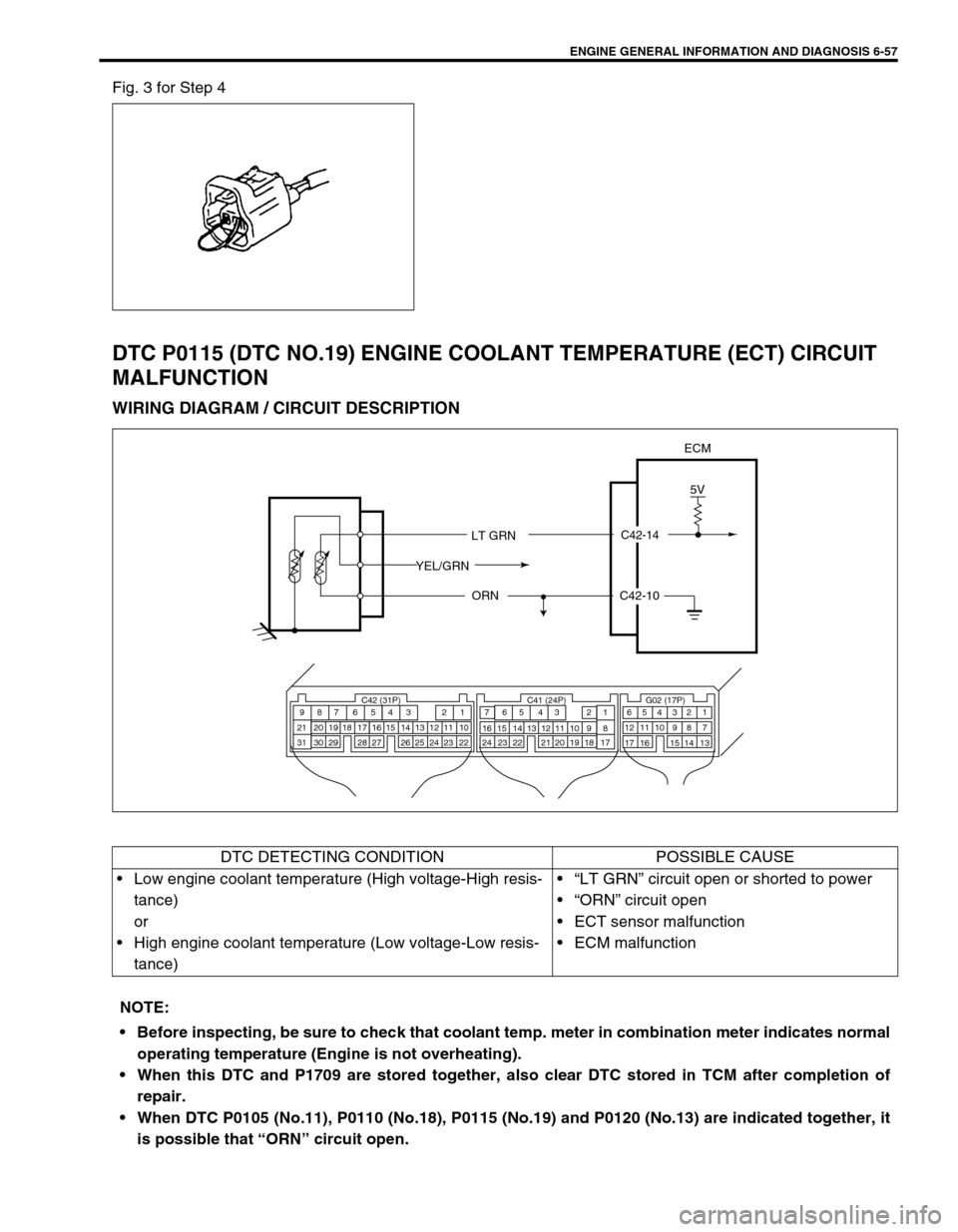
ENGINE GENERAL INFORMATION AND DIAGNOSIS 6-57
Fig. 3 for Step 4
DTC P0115 (DTC NO.19) ENGINE COOLANT TEMPERATURE (ECT) CIRCUIT
MALFUNCTION
WIRING DIAGRAM / CIRCUIT DESCRIPTION
C42-14
5V
ECM
LT GRN
ORN
YEL/GRN
C42-10
C42 (31P) C41 (24P) G02 (17P)1 2 3 4 5 6 7 8 9
10 11 12 13 14 15 16 17 18 19 20 21
22 23 24 25 26 28 27 29 30 315 6
1 2 3 4 5 6 7
11 12
9 10 11 13 12 14 15 16
16 171 2
7 8
13 14 3 4
9 10
15 17 188
19 20 21 22 23 24
DTC DETECTING CONDITION POSSIBLE CAUSE
Low engine coolant temperature (High voltage-High resis-
tance)
or
High engine coolant temperature (Low voltage-Low resis-
tance)“LT GRN” circuit open or shorted to power
“ORN” circuit open
ECT sensor malfunction
ECM malfunction
NOTE:
Before inspecting, be sure to check that coolant temp. meter in combination meter indicates normal
operating temperature (Engine is not overheating).
When this DTC and P1709 are stored together, also clear DTC stored in TCM after completion of
repair.
When DTC P0105 (No.11), P0110 (No.18), P0115 (No.19) and P0120 (No.13) are indicated together, it
is possible that “ORN” circuit open.
Page 427 of 698
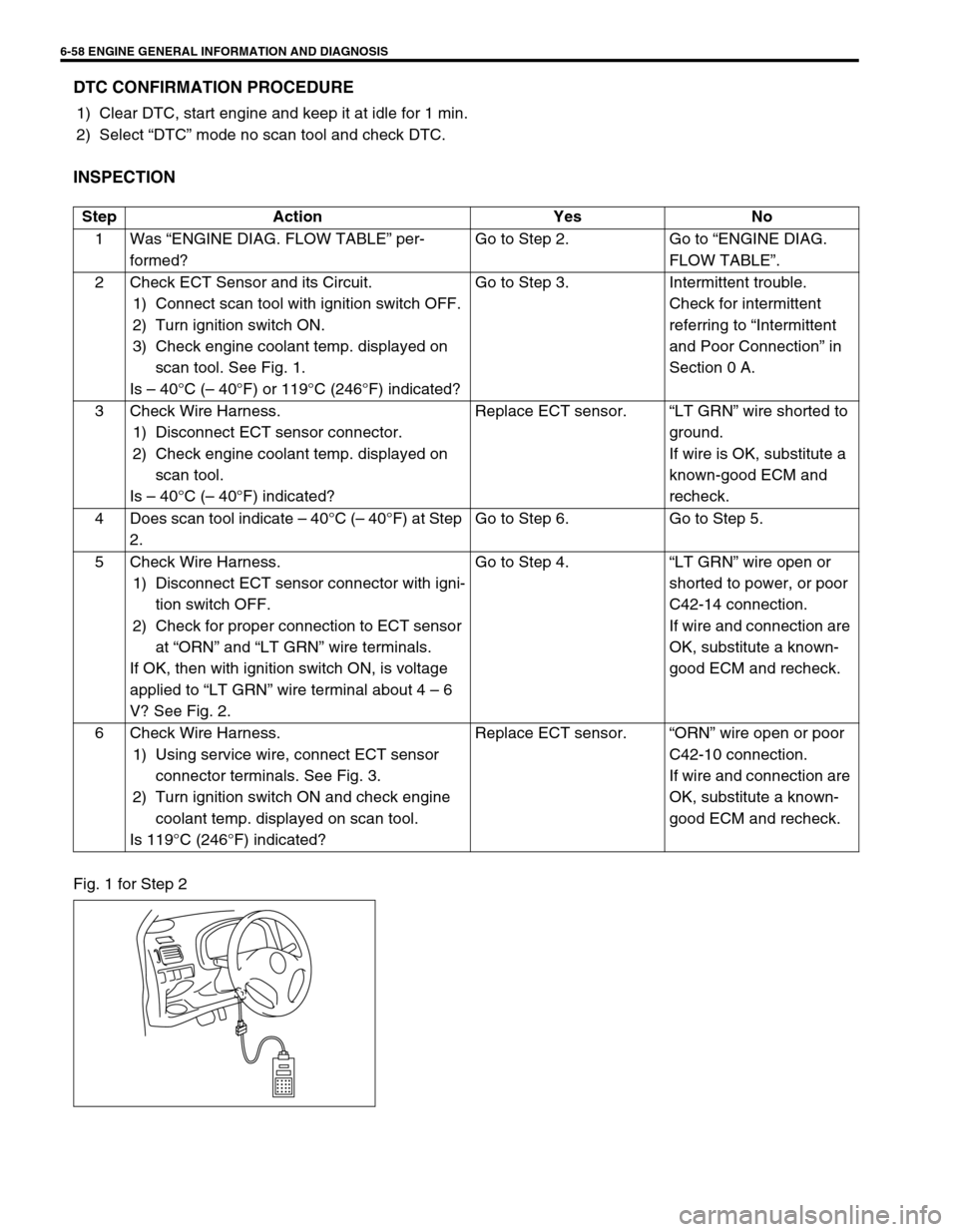
6-58 ENGINE GENERAL INFORMATION AND DIAGNOSIS
DTC CONFIRMATION PROCEDURE
1) Clear DTC, start engine and keep it at idle for 1 min.
2) Select “DTC” mode no scan tool and check DTC.
INSPECTION
Fig. 1 for Step 2Step Action Yes No
1Was “ENGINE DIAG. FLOW TABLE” per-
formed?Go to Step 2. Go to “ENGINE DIAG.
FLOW TABLE”.
2 Check ECT Sensor and its Circuit.
1) Connect scan tool with ignition switch OFF.
2) Turn ignition switch ON.
3) Check engine coolant temp. displayed on
scan tool. See Fig. 1.
Is – 40°C (– 40°F) or 119°C (246°F) indicated?Go to Step 3. Intermittent trouble.
Check for intermittent
referring to “Intermittent
and Poor Connection” in
Section 0 A.
3 Check Wire Harness.
1) Disconnect ECT sensor connector.
2) Check engine coolant temp. displayed on
scan tool.
Is – 40°C (– 40°F) indicated?Replace ECT sensor.“LT GRN” wire shorted to
ground.
If wire is OK, substitute a
known-good ECM and
recheck.
4 Does scan tool indicate – 40°C (– 40°F) at Step
2.Go to Step 6. Go to Step 5.
5 Check Wire Harness.
1) Disconnect ECT sensor connector with igni-
tion switch OFF.
2) Check for proper connection to ECT sensor
at “ORN” and “LT GRN” wire terminals.
If OK, then with ignition switch ON, is voltage
applied to “LT GRN” wire terminal about 4 – 6
V? See Fig. 2.Go to Step 4.“LT GRN” wire open or
shorted to power, or poor
C42-14 connection.
If wire and connection are
OK, substitute a known-
good ECM and recheck.
6 Check Wire Harness.
1) Using service wire, connect ECT sensor
connector terminals. See Fig. 3.
2) Turn ignition switch ON and check engine
coolant temp. displayed on scan tool.
Is 119°C (246°F) indicated?Replace ECT sensor.“ORN” wire open or poor
C42-10 connection.
If wire and connection are
OK, substitute a known-
good ECM and recheck.
Page 429 of 698

6-60 ENGINE GENERAL INFORMATION AND DIAGNOSIS
DTC P0120 (DTC NO.13) THROTTLE POSITION CIRCUIT MALFUNCTION
WIRING DIAGRAM / CIRCUIT DESCRIPTION
DTC CONFIRMATION PROCEDURE
1) Clear DTC, start engine and keep it at idle for 1 min.
2) Select “DTC” mode no scan tool and check DTC.
[A] : Case of TYPE A is shown (See NOTE) [B] : Case of TYPE B is shown (See NOTE)
DTC DETECTING CONDITION POSSIBLE CAUSE
Signal voltage high
or
Signal voltage low“ORN” circuit open
“GRY/BLU” circuit open or shorted to ground
“GRY/RED” circuit open or shorted to power or ground
TP sensor malfunction
ECM malfunction
C42-10
C42-22
5V5V
ECM
GRY/RED
GRY/BLU
ORN
C42 (31P) C41 (24P) G02 (17P)1 2 3 4 5 6 7 8 9
10 11 12 13 14 15 16 17 18 19 20 21
22 23 24 25 26 28 27 29 30 315 6
1 2 3 4 5 6 7
11 12
9 10 11 13 12 14 15 16
16 171 2
7 8
13 14 3 4
9 10
15 17 188
19 20 21 22 23 24
C42-16 [B] C41-3 [A]
NOTE:
For TYPE A and TYOE B, refer to NOTE in “ECM VOLTAGE VALUES TABLE” for applicable model.
When DTC P0105 (No.11), P0110 (No.18), P0115 (No.19) and P0120 (No.13) are indicated together, it
is possible that “ORN” or “GRY/RED” circuit is open.
When this DTC and P1700 are stored together, also clear DTC stored in TCM after completion of
repair.
When this DTC and DTC P0105 (No.11) are indicated together, it is possible that “GRY/RED” circuit
is open.
Page 430 of 698
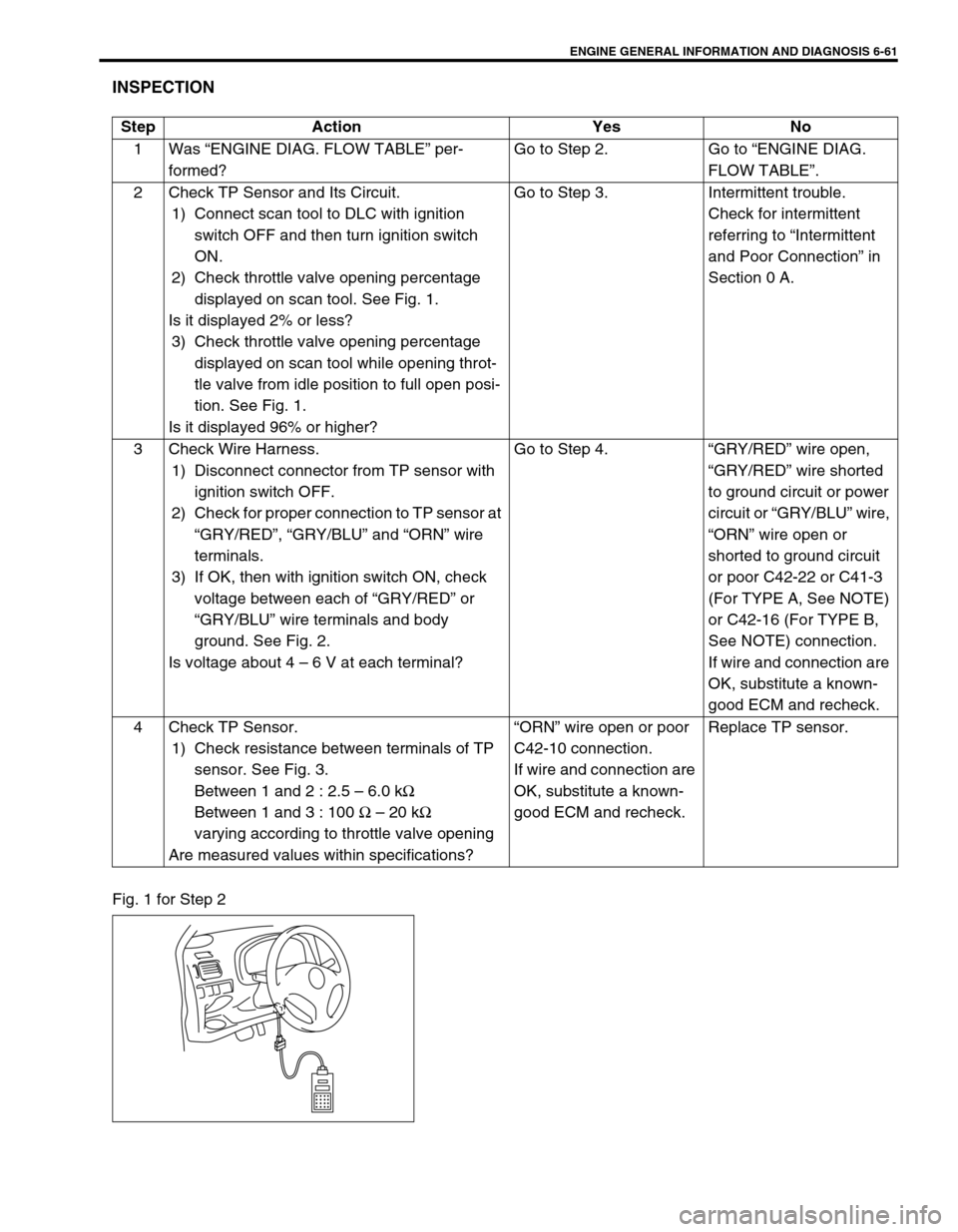
ENGINE GENERAL INFORMATION AND DIAGNOSIS 6-61
INSPECTION
Fig. 1 for Step 2Step Action Yes No
1Was “ENGINE DIAG. FLOW TABLE” per-
formed?Go to Step 2. Go to “ENGINE DIAG.
FLOW TABLE”.
2 Check TP Sensor and Its Circuit.
1) Connect scan tool to DLC with ignition
switch OFF and then turn ignition switch
ON.
2) Check throttle valve opening percentage
displayed on scan tool. See Fig. 1.
Is it displayed 2% or less?
3) Check throttle valve opening percentage
displayed on scan tool while opening throt-
tle valve from idle position to full open posi-
tion. See Fig. 1.
Is it displayed 96% or higher?Go to Step 3. Intermittent trouble.
Check for intermittent
referring to “Intermittent
and Poor Connection” in
Section 0 A.
3 Check Wire Harness.
1) Disconnect connector from TP sensor with
ignition switch OFF.
2) Check for proper connection to TP sensor at
“GRY/RED”, “GRY/BLU” and “ORN” wire
terminals.
3) If OK, then with ignition switch ON, check
voltage between each of “GRY/RED” or
“GRY/BLU” wire terminals and body
ground. See Fig. 2.
Is voltage about 4 – 6 V at each terminal?Go to Step 4.“GRY/RED” wire open,
“GRY/RED” wire shorted
to ground circuit or power
circuit or “GRY/BLU” wire,
“ORN” wire open or
shorted to ground circuit
or poor C42-22 or C41-3
(For TYPE A, See NOTE)
or C42-16 (For TYPE B,
See NOTE) connection.
If wire and connection are
OK, substitute a known-
good ECM and recheck.
4 Check TP Sensor.
1) Check resistance between terminals of TP
sensor. See Fig. 3.
Between 1 and 2 : 2.5 – 6.0 kΩ
Between 1 and 3 : 100 Ω – 20 kΩ
varying according to throttle valve opening
Are measured values within specifications?“ORN” wire open or poor
C42-10 connection.
If wire and connection are
OK, substitute a known-
good ECM and recheck.Replace TP sensor.
Page 432 of 698
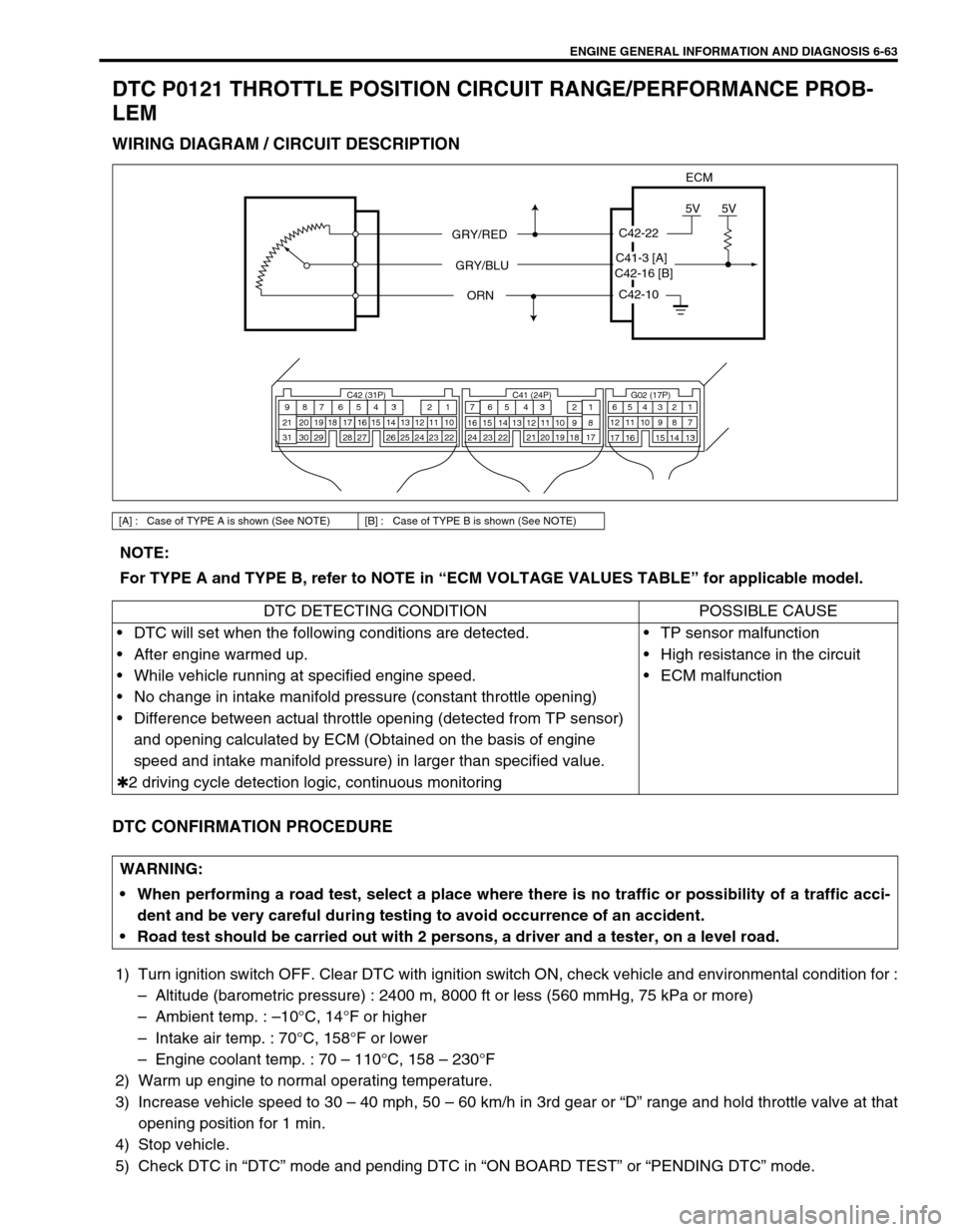
ENGINE GENERAL INFORMATION AND DIAGNOSIS 6-63
DTC P0121 THROTTLE POSITION CIRCUIT RANGE/PERFORMANCE PROB-
LEM
WIRING DIAGRAM / CIRCUIT DESCRIPTION
DTC CONFIRMATION PROCEDURE
1) Turn ignition switch OFF. Clear DTC with ignition switch ON, check vehicle and environmental condition for :
–Altitude (barometric pressure) : 2400 m, 8000 ft or less (560 mmHg, 75 kPa or more)
–Ambient temp. : –10°C, 14°F or higher
–Intake air temp. : 70°C, 158°F or lower
–Engine coolant temp. : 70 – 110°C, 158 – 230°F
2) Warm up engine to normal operating temperature.
3) Increase vehicle speed to 30 – 40 mph, 50 – 60 km/h in 3rd gear or “D” range and hold throttle valve at that
opening position for 1 min.
4) Stop vehicle.
5) Check DTC in “DTC” mode and pending DTC in “ON BOARD TEST” or “PENDING DTC” mode.
[A] : Case of TYPE A is shown (See NOTE) [B] : Case of TYPE B is shown (See NOTE)
C42-10
C42-22
5V5V
ECM
GRY/RED
GRY/BLU
ORN
C42 (31P) C41 (24P) G02 (17P)1 2 3 4 5 6 7 8 9
10 11 12 13 14 15 16 17 18 19 20 21
22 23 24 25 26 28 27 29 30 315 6
1 2 3 4 5 6 7
11 12
9 10 11 13 12 14 15 16
16 171 2
7 8
13 14 3 4
9 10
15 17 188
19 20 21 22 23 24
C42-16 [B]C41-3 [A]
NOTE:
For TYPE A and TYPE B, refer to NOTE in “ECM VOLTAGE VALUES TABLE” for applicable model.
DTC DETECTING CONDITION POSSIBLE CAUSE
DTC will set when the following conditions are detected.
After engine warmed up.
While vehicle running at specified engine speed.
No change in intake manifold pressure (constant throttle opening)
Difference between actual throttle opening (detected from TP sensor)
and opening calculated by ECM (Obtained on the basis of engine
speed and intake manifold pressure) in larger than specified value.
✱2 driving cycle detection logic, continuous monitoringTP sensor malfunction
High resistance in the circuit
ECM malfunction
WARNING:
When performing a road test, select a place where there is no traffic or possibility of a traffic acci-
dent and be very careful during testing to avoid occurrence of an accident.
Road test should be carried out with 2 persons, a driver and a tester, on a level road.
Page 433 of 698
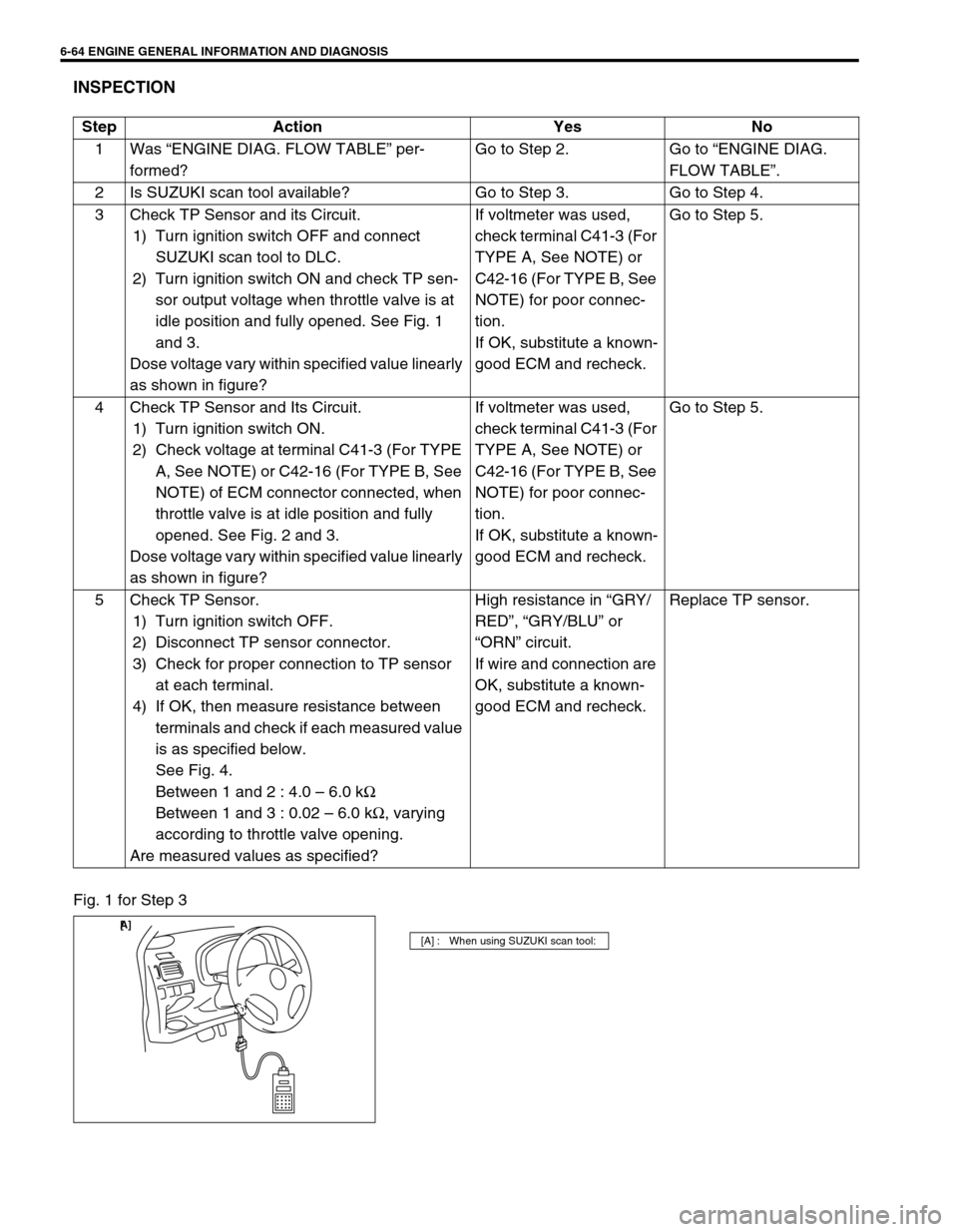
6-64 ENGINE GENERAL INFORMATION AND DIAGNOSIS
INSPECTION
Fig. 1 for Step 3Step Action Yes No
1Was “ENGINE DIAG. FLOW TABLE” per-
formed?Go to Step 2. Go to “ENGINE DIAG.
FLOW TABLE”.
2 Is SUZUKI scan tool available? Go to Step 3. Go to Step 4.
3 Check TP Sensor and its Circuit.
1) Turn ignition switch OFF and connect
SUZUKI scan tool to DLC.
2) Turn ignition switch ON and check TP sen-
sor output voltage when throttle valve is at
idle position and fully opened. See Fig. 1
and 3.
Dose voltage vary within specified value linearly
as shown in figure?If voltmeter was used,
check terminal C41-3 (For
TYPE A, See NOTE) or
C42-16 (For TYPE B, See
NOTE) for poor connec-
tion.
If OK, substitute a known-
good ECM and recheck.Go to Step 5.
4 Check TP Sensor and Its Circuit.
1) Turn ignition switch ON.
2) Check voltage at terminal C41-3 (For TYPE
A, See NOTE) or C42-16 (For TYPE B, See
NOTE) of ECM connector connected, when
throttle valve is at idle position and fully
opened. See Fig. 2 and 3.
Dose voltage vary within specified value linearly
as shown in figure?If voltmeter was used,
check terminal C41-3 (For
TYPE A, See NOTE) or
C42-16 (For TYPE B, See
NOTE) for poor connec-
tion.
If OK, substitute a known-
good ECM and recheck.Go to Step 5.
5 Check TP Sensor.
1) Turn ignition switch OFF.
2) Disconnect TP sensor connector.
3) Check for proper connection to TP sensor
at each terminal.
4) If OK, then measure resistance between
terminals and check if each measured value
is as specified below.
See Fig. 4.
Between 1 and 2 : 4.0 – 6.0 kΩ
Between 1 and 3 : 0.02 – 6.0 kΩ, varying
according to throttle valve opening.
Are measured values as specified?High resistance in “GRY/
RED”, “GRY/BLU” or
“ORN” circuit.
If wire and connection are
OK, substitute a known-
good ECM and recheck.Replace TP sensor.
[A] : When using SUZUKI scan tool:
[ A]
Page 435 of 698
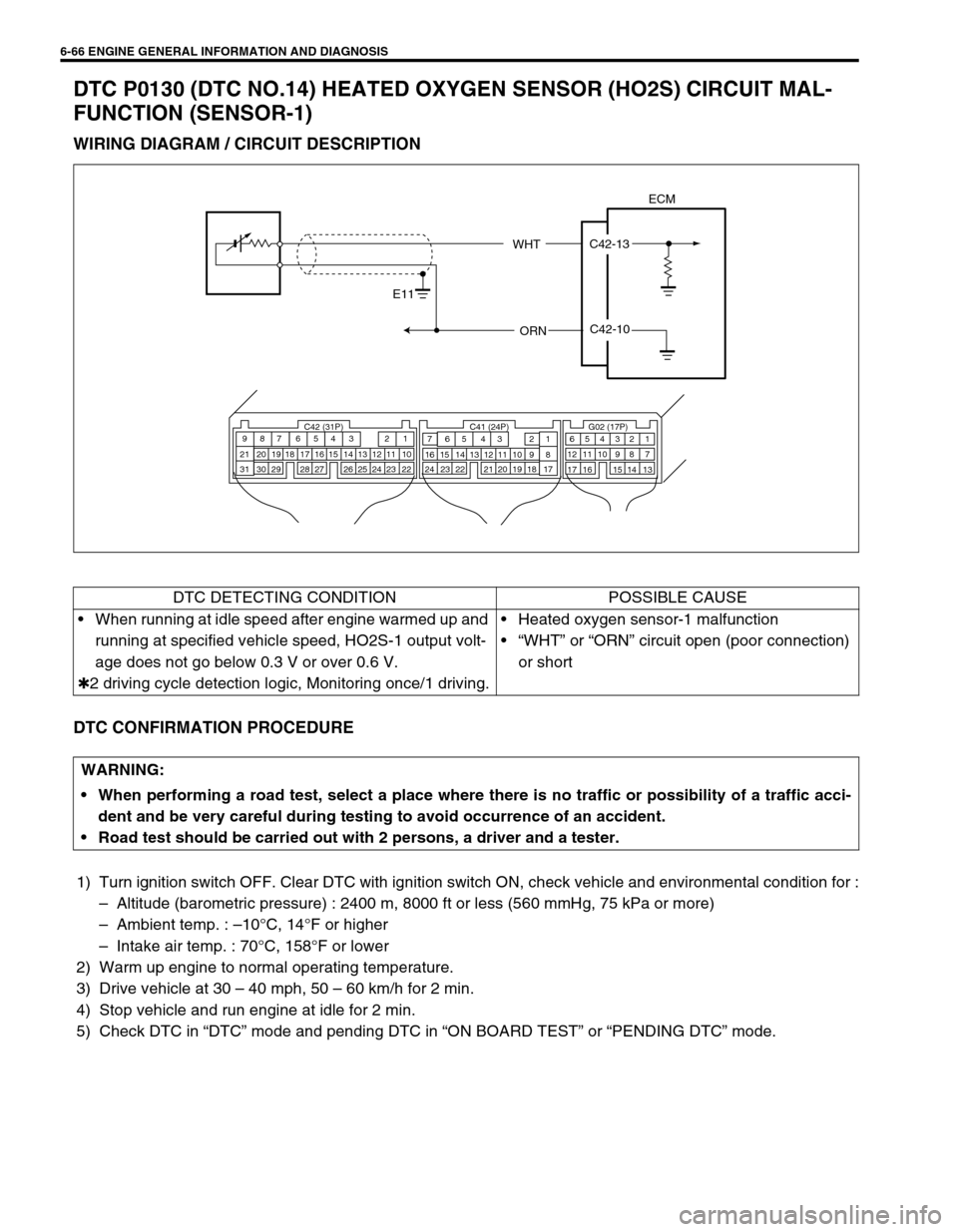
6-66 ENGINE GENERAL INFORMATION AND DIAGNOSIS
DTC P0130 (DTC NO.14) HEATED OXYGEN SENSOR (HO2S) CIRCUIT MAL-
FUNCTION (SENSOR-1)
WIRING DIAGRAM / CIRCUIT DESCRIPTION
DTC CONFIRMATION PROCEDURE
1) Turn ignition switch OFF. Clear DTC with ignition switch ON, check vehicle and environmental condition for :
–Altitude (barometric pressure) : 2400 m, 8000 ft or less (560 mmHg, 75 kPa or more)
–Ambient temp. : –10°C, 14°F or higher
–Intake air temp. : 70°C, 158°F or lower
2) Warm up engine to normal operating temperature.
3) Drive vehicle at 30 – 40 mph, 50 – 60 km/h for 2 min.
4) Stop vehicle and run engine at idle for 2 min.
5) Check DTC in “DTC” mode and pending DTC in “ON BOARD TEST” or “PENDING DTC” mode.
ECM
WHT
ORNC42-10 C42-13
E11
C42 (31P) C41 (24P) G02 (17P)1 2 3 4 5 6 7 8 9
10 11 12 13 14 15 16 17 18 19 20 21
22 23 24 25 26 28 27 29 30 315 6
1 2 3 4 5 6 7
11 12
9 10 11 13 12 14 15 16
16 171 2
7 8
13 14 3 4
9 10
15 17 188
19 20 21 22 23 24
DTC DETECTING CONDITION POSSIBLE CAUSE
When running at idle speed after engine warmed up and
running at specified vehicle speed, HO2S-1 output volt-
age does not go below 0.3 V or over 0.6 V.
✱2 driving cycle detection logic, Monitoring once/1 driving.Heated oxygen sensor-1 malfunction
“WHT” or “ORN” circuit open (poor connection)
or short
WARNING:
When performing a road test, select a place where there is no traffic or possibility of a traffic acci-
dent and be very careful during testing to avoid occurrence of an accident.
Road test should be carried out with 2 persons, a driver and a tester.
Page 437 of 698
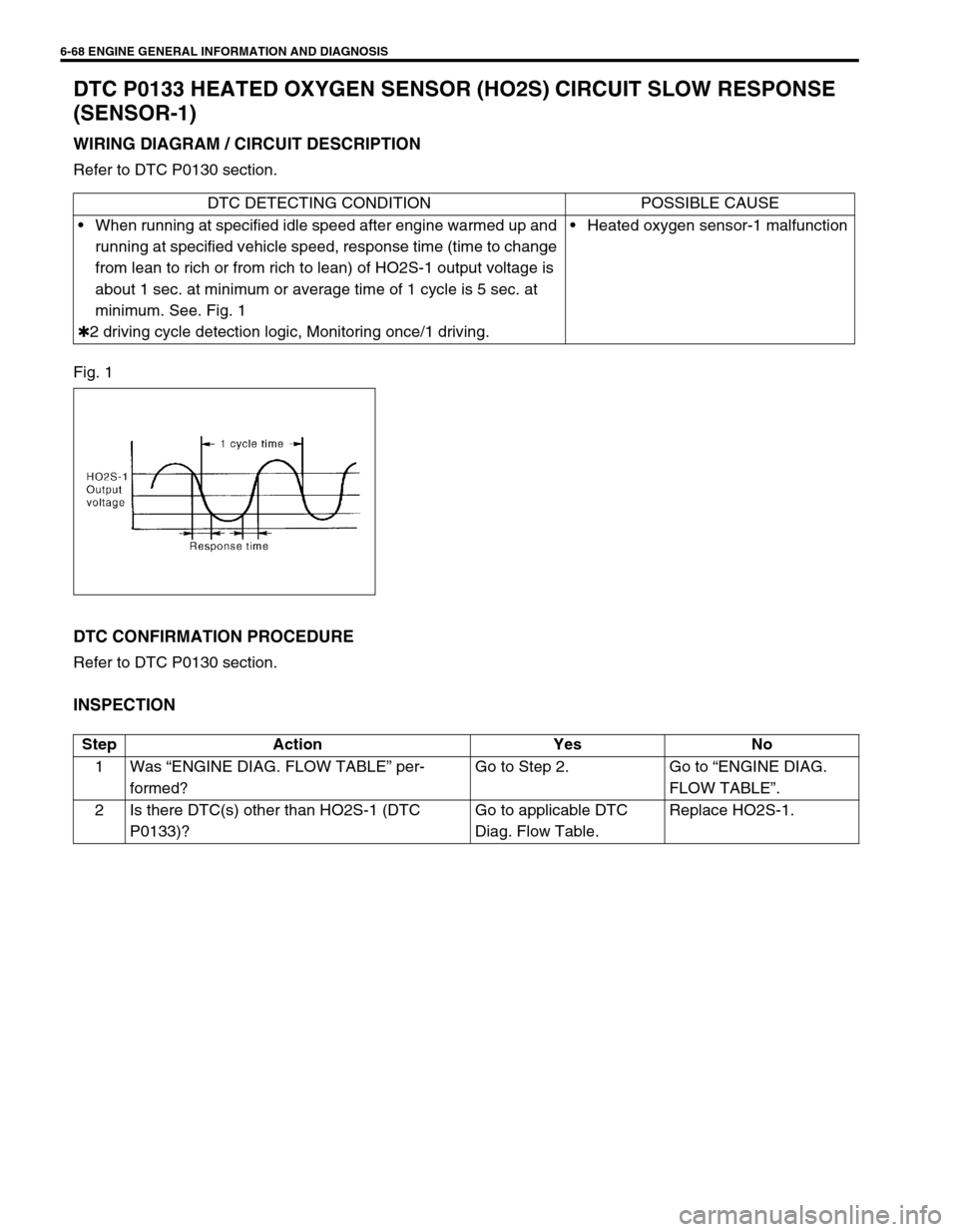
6-68 ENGINE GENERAL INFORMATION AND DIAGNOSIS
DTC P0133 HEATED OXYGEN SENSOR (HO2S) CIRCUIT SLOW RESPONSE
(SENSOR-1)
WIRING DIAGRAM / CIRCUIT DESCRIPTION
Refer to DTC P0130 section.
Fig. 1
DTC CONFIRMATION PROCEDURE
Refer to DTC P0130 section.
INSPECTION
DTC DETECTING CONDITION POSSIBLE CAUSE
When running at specified idle speed after engine warmed up and
running at specified vehicle speed, response time (time to change
from lean to rich or from rich to lean) of HO2S-1 output voltage is
about 1 sec. at minimum or average time of 1 cycle is 5 sec. at
minimum. See. Fig. 1
✱2 driving cycle detection logic, Monitoring once/1 driving.Heated oxygen sensor-1 malfunction
Step Action Yes No
1Was “ENGINE DIAG. FLOW TABLE” per-
formed?Go to Step 2. Go to “ENGINE DIAG.
FLOW TABLE”.
2 Is there DTC(s) other than HO2S-1 (DTC
P0133)?Go to applicable DTC
Diag. Flow Table.Replace HO2S-1.
Page 438 of 698

ENGINE GENERAL INFORMATION AND DIAGNOSIS 6-69
DTC P0134 HEATED OXYGEN SENSOR (HO2S) CIRCUIT NO ACTIVITY
DETECTED (SENSOR-1)
WIRING DIAGRAM / CIRCUIT DESCRIPTION
Refer to DTC P0130 section.
DTC CONFIRMATION PROCEDURE
Refer to DTC P0131 section.
INSPECTION
Fig. 1 for Step 3DTC DETECTING CONDITION POSSIBLE CAUSE
Engine warmed up.
While running under other than high load and high engine speed
conditions or at specified idle speed (engine is in closed loop con-
dition), HO2S-1 output voltage is high or low continuously.
✱2 driving cycle detection logic, Continuous monitoring.“WHT” or “ORN” circuit open or short
Heated oxygen sensor malfunction
Fuel system malfunction
Exhaust gas leakage
Step Action Yes No
1Was “ENGINE DIAG. FLOW TABLE” per-
formed?Go to Step 2. Go to “ENGINE DIAG.
FLOW TABLE”.
2 Is there DTC(s) other than Fuel system
(DTC P0171/P0172) and HO2S-1 (DTC
P0134)?Go to applicable DTC
Diag. Flow Table.Go to Step 3.
3 Check HO2S-1 and Its Circuit.
1) Connect scan tool to DLC with ignition
switch OFF.
2) Warm up engine to normal operating tem-
perature and keep it at 2000 r/min. for 60
sec.
3) Repeat racing engine (Repeat depressing
accelerator pedal 5 to 6 times continuously
and take foot off from pedal to enrich and
enlean A/F mixture). See Fig. 1.
Does HO2S-1 output voltage deflect between
0.3V and over 0.6V repeatedly?Go to DTC P0171 and
P0172 Diag. Flow Table
(Fuel System Check).Check “WHT” and “ORN”
wires for open and short,
and connections for poor
connection. If wires and
connections are OK,
replace HO2S-1.